|
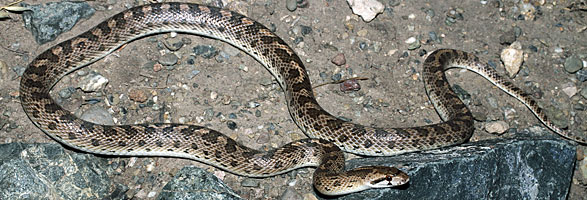 |
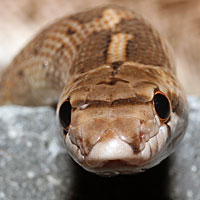 |
| Adult, Alameda County |
 |
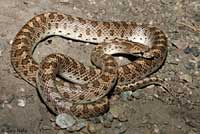 |
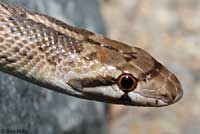 |
 |
| Adult, Alameda County |
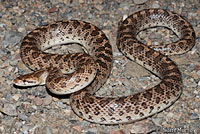 |
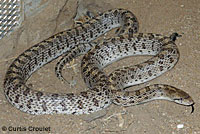 |
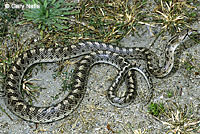 |
 |
Adult, San Joaquin County
© Sam Murray |
Adult, Anza, approx. 3,900 ft,
Riverside County © Curtis Croulet
|
Adult, Alameda County © Gary Nafis Specimen Courtesy of Josh Shatsky |
 |
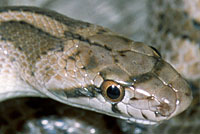 |
 |
 |
| Adult, Alameda County. © Gary Nafis. Specimen Courtesy of Josh Shatsky |
Adult, San Joaquin County
© Sam Murray |
 |
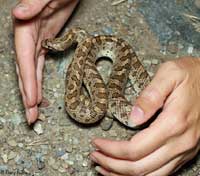 |
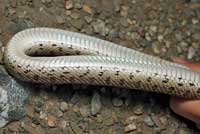 |
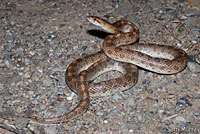 |
| Adult, Alameda County. © Gary Nafis. Specimen courtesy of John Worden. |
Adult, San Joaquin County
© Sam Murray
|
 |
 |
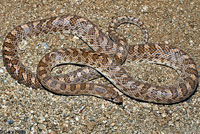 |
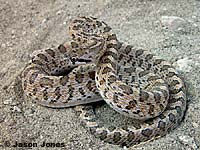 |
| Adult, San Diego County |
Adult, coastal San Diego County
© Jason Jones |
 |
 |
 |
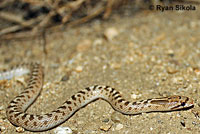 |
| Adult, Fresno County © Patrick Briggs |
Adult, western Kern County
© Ryan Sikola |
Adult, western Kern County
© Ryan Sikola |
 |
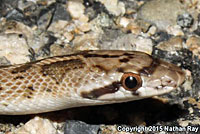 |
 |
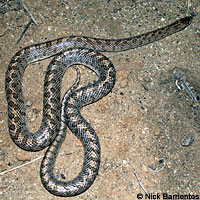 |
| Adult, coastal Riverside County © Nathan Ray |
Adult, coastal Riverside County © Nick Barrientos |
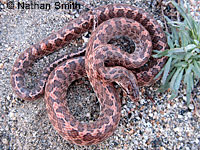 |
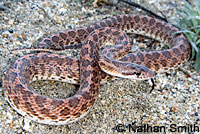 |
 |
 |
| Adult with high red coloring, San Diego County © Nathan Smith |
Adult, Riverside County
© Brody Trent |
 |
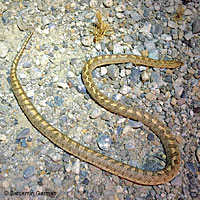 |
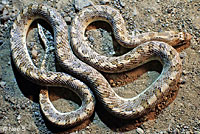 |
 |
Adult, about four feet in length,
San Joaquin County © Adam Gitmed |
Adult from the eastern edge of Monterey County © Benjamin German |
Adult, San Benito County © Neo S |
Glossy Snakes, like this Alameda County adult, sometimes show iridescence on the underside.
© Richard Porter |
| \ |
|
|
|
| Juveniles |
 |
 |
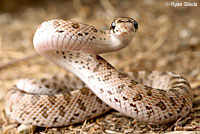 |
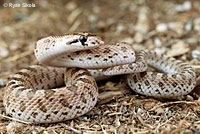 |
| Sub-adult, San Diego County |
Juvenile, San Luis Obispo County © Ryan Sikola |
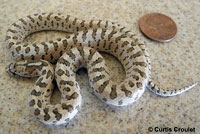 |
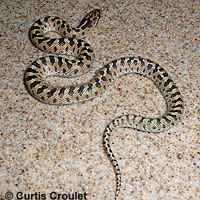 |
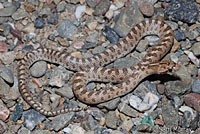 |
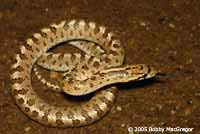 |
Juvenile, Anza, aprox. 3,900 ft,
Riverside County © Curtis Croulet |
Juvenile, Anza, aprox. 3,900 ft,
Riverside County © Curtis Croulet |
Juvenile, San Joaquin County
© Sam Murray |
Juvenile, Fresno County
© Bobby MacGregor |
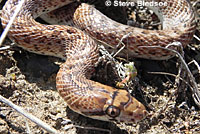 |
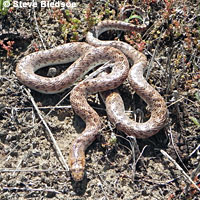 |
 |
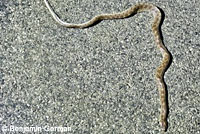 |
| Juvenile, Orange County © Steve Bledsoe |
Juvenile, Santa Barbara County
© Ryan Sikola |
DOR Adult, Monterey County
© Benjamin German |
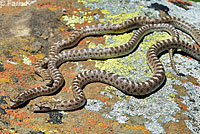 |
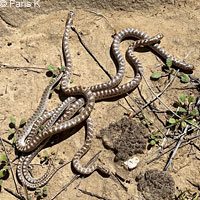 |
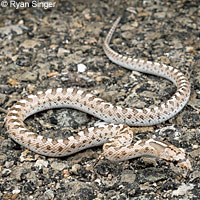 |
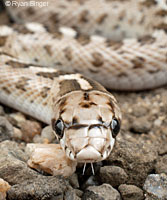 |
Several juvenile glossy snakes found in close proximity in Stanislaus County
© Faris K |
Juvenile, found in San Luis Obispo County in a new location
west of the Carrizo Plain © Ryan Singer |
| |
|
|
|
Snakes from areas near where two subspecies come into contact.
(Intergrades - or subspecies unknown) |
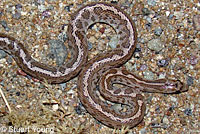 |
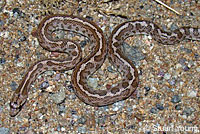 |
 |
|
Striped juvenile, possible intergrade with A. e. eburnata - Desert Glossy Snake,
San Diego County © Stuart Young |
Striped Adult possible intergrade wth
A. e. eburnata - Desert Glossy Snake,
San Diego County © Ross Padilla |
|
| |
|
|
|
| Habitat |
 |
 |
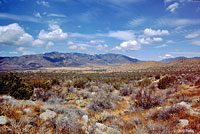 |
 |
Habitat, Alameda County foothills
|
Habitat, Alameda County foothills |
Habitat, San Diego County |
Habitat, east side of Santa Ana Mountains, Riverside County
© Nick Barrientos |
| |
|
|
|
| Short Video |
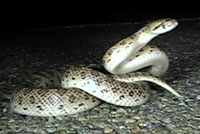 |
|
|
|
| A California Glossy Snake crawls on a road at night, crossing paths with a potato bug. |
|
|
|
|
|
|
|
| Description |
Not Dangerous - This snake does not have venom that can cause death or serious illness or injury in most humans.
Commonly described as "harmless" or "not poisonous" to indicate that its bite is not dangerous, but "not venomous" is more accurate. (A poisonous snake can hurt you if you eat it. A venomous snake can hurt you if it bites you.)
|
| Length |
Adults are 26-70 inches in length (66-178 cm). (Stebbins, 2003) Average length is 3 - 4 feet.
|
| Appearance |
A medium-sized muscular snake with smooth, glossy scales, a faded or bleached-out appearance, and a short tail.
Rostral scale (on the nose) is enlarged for digging (but not as much so as that of a patch-nosed snake or a leaf-nosed snake.)
Pupils are rounded. |
| Color and Pattern |
Generally darker than other California Glossy snake subspecies - a tan or light brown ground color with dark brown blotches with dark edges on the back and sides and a pale, unmarked underside.
Dark line behind each eye and a dark line (a "unibrow") between the eyes.
An average of 63 narrow blotches on body. |
| Similar Snakes |
Comparison of the 3 subspecies of Arizona elegans in California, along with sympatric species similar in appearance - Pituophis catenifer - Gopher Snake,
Trimorphodon biscutatus - Lyre Snake,
Hypsiglena - Night Snakes,
Coluber constrictor mormon - Western Yellow-Bellied Racer (juvenile).
|
| Life History and Behavior |
Activity |
Nocturnal.
Hides underground in daytime under rocks, in existing burrows, or uses its specialized nose to make its own burrow.
Typically active from late February until November, depending on the weather. Most active in May. Less active during Summer. |
| Diet and Feeding |
Preys mostly on sleeping diurnal lizards, but also eats small snakes, terrestrial birds, and nocturnally-active mammals.
Hunts active mammals at night by waiting in ambush.
Kills prey by direct swallowing or constriction. |
| Reproduction |
Females are oviparous - laying from 3 - 23 eggs (more often 5-12) in June and July. (Stebbins, 2003)
Eggs most likely hatch in late summer and early fall. (Probably late September and October.)
|
| Habitat |
Inhabits arid scrub, rocky washes, grasslands, chaparral.
Appears to prefer microhabitats of open areas and areas with soil loose enough for easy burrowing.
|
| Geographical Range |
This subspecies, Arizona elegans occidentalis - California Glossy Snake, occurs from the eastern part of the San Francisco Bay Area south to northwestern Baja California. It is absent along the central coast. There are also old reports of this snake from the Santa Monica Mountains.
In July 2023, Benjamin German found a California Glossy Snake dead on a road in Monterey County (depicted above) which might be the first county record for the species.
The species Arizona elegans - Western Glossy Snake, has a very wide range, occurring through most of the southwest, and the southeastern part of the Midwest, and south into Mexico, including northern Baja California.
|
 |
| Elevational Range |
The species is found from below sea level to around 7,218 ft. (2,200 m). (Stebbins, 2003)
|
| Notes on Taxonomy |
Collins elevated the western Glossy Snakes - A. e. occidentalis, A. e. eburnata, and A. e. candida - to specific status (Arizona occidentalis) (1991, Herp. Review 22:42-43) with the eastern Glossy Snakes remaining Arizona elegans, but this change has not been widely accepted.
-------------------------------------------------------------------------------------------------------------------------------------------------------------------------------------------------------------------------------
"Using genetic data, Myers et al. (2017, Journal of Biogeography 44: 461–474; Myers et al., 2019, Molecular Ecology 28: 4535-4548) and Dahn et al. (2018, Molecular Phylogenetics and Evolution 129: 214–225) confirmed that the eastern and western populations were distinct as predicted by Collins (1991, Herpetological Review 22: 42–43). However, neither study recommended taxonomic changes."
(Nicholson, K. E. (ed.). 2025 SSAR Scientific and Standard English Names List)
-------------------------------------------------------------------------------------------------------------------------------------------------------------------------------------------------------------------------------
Alternate and Previous Names (Synonyms)
Arizona elegans occidentalis - California Glossy Snake (Stebbins 1966, 1985, 2003, 2012)
Arizona elegans occidentalis - Western Faded Snake (Faded Snake, California or Western Glossy Snake, Smooth-scaled Coluber, Smooth-scaled Gopher Snake) (Wright & Wright 1957)
Arizona elegans occidentalis (Blanchard, 1924, Klauber 1938)
Arizona elegans - Faded Snake (Rhinechis elegans; Coluber arizonae. Smooth-scaled Coluber) (Grinnell and Camp 1917)
Arizona elegans (Kennicott, 1859)
|
| Conservation Issues (Conservation Status) |
Designated a California Species of Special Concern
"The greatest threat to this subspecies is habitat modification due to agricultural, commercial, and residential development. However, the specific mechanisms that cause declines are not well understood."
(Robert C. Thomson, Amber N. Wright, and H. Bradley Shaffer. California Amphibian and Reptile Species of Special Concern. University of California Press, 2016.)
Protected from take with a sport fishing license beginning in 2013 by a special closure:
"No glossy snakes (Arizona elegans) may be taken in the following counties: Alameda, Fresno, Imperial (west of Hwy 111), Kern, Los Angeles, Riverside (southwest of Hwy 111 and I-10), San Benito, San Bernardino (West of I-215 and Hwy 138), San Diego, San Joaquin, San Luis Obispo, Santa Barbara, Santa Clara and Tulare." |
|
| Taxonomy |
| Family |
Colubridae |
Colubrids |
Oppel, 1811 |
| Genus |
Arizona |
Glossy Snakes |
Kennicott, 1859 |
| Species |
elegans |
Glossy Snake |
Kennicott, 1859 |
Subspecies
|
occidentalis |
California Glossy Snake |
Blanchard, 1924 |
|
Original description |
Arizona elegans - Kennicott, 1859 - in Baird, U.S. Mex.
Arizona elegans occidentalis - Blanchard, 1924 - Occ. Papers Mus. Zool. Univ. Michigan, No. 150, p. 1
from Original Description Citations for the Reptiles and Amphibians of North America © Ellin Beltz
|
|
Meaning of the Scientific Name |
Arizona - 1.) Latin - areo = to be dry + zona = belt of earth - refers to the geographical distribution
2.) Native American Indian word - arizonac = place of springs, refers to the Arizona region
elegans - Latin = fine or elegant - refers to the color pattern
occidentalis - Latin - western - refers to its western distribution in the U.S.
from Scientific and Common Names of the Reptiles and Amphibians of North America - Explained © Ellin Beltz
|
|
Alternate Names |
Arizona occidentalis occidentalis
Arizona elegans - Common Glossy Snake (Nicholson, K. E. (ed.). 2025 SSAR Scientific and Standard English Names List)
|
|
Related or Similar Neighboring California Snakes |
A. e. candida - Mohave Glossy Snake
A. e. eburnata - Desert Glossy Snake
P. c. catenifer - Pacific Gophersnake
P. c. annectens - San Diego Gophersnake
|
|
More Information and References |
California Department of Fish and Wildlife
Hansen, Robert W. and Shedd, Jackson D. California Amphibians and Reptiles. (Princeton Field Guides.) Princeton University Press, 2025.
Stebbins, Robert C., and McGinnis, Samuel M. Field Guide to Amphibians and Reptiles of California: Revised Edition (California Natural History Guides) University of California Press, 2012.
Stebbins, Robert C. California Amphibians and Reptiles. The University of California Press, 1972.
Flaxington, William C. Amphibians and Reptiles of California: Field Observations, Distribution, and Natural History. Fieldnotes Press, Anaheim, California, 2021.
Nicholson, K. E. (ed.). 2025. Scientific and Standard English Names of Amphibians and Reptiles of North America North of Mexico, with Comments Regarding Confidence in Our Understanding. Ninth Edition. Society for the Study of Amphibians and Reptiles. [SSAR] 87pp.
Samuel M. McGinnis and Robert C. Stebbins. Peterson Field Guide to Western Reptiles & Amphibians. 4th Edition. Houghton Mifflin Harcourt Publishing Company, 2018.
Stebbins, Robert C. A Field Guide to Western Reptiles and Amphibians. 3rd Edition. Houghton Mifflin Company, 2003.
Behler, John L., and F. Wayne King. The Audubon Society Field Guide to North American Reptiles and Amphibians. Alfred A. Knopf, 1992.
Robert Powell, Roger Conant, and Joseph T. Collins. Peterson Field Guide to Reptiles and Amphibians of Eastern and Central North America. Fourth Edition. Houghton Mifflin Harcourt, 2016.
Powell, Robert., Joseph T. Collins, and Errol D. Hooper Jr. A Key to Amphibians and Reptiles of the Continental United States and Canada. The University Press of Kansas, 1998.
Bartlett, R. D. & Patricia P. Bartlett. Guide and Reference to the Snakes of Western North America (North of Mexico) and Hawaii. University Press of Florida, 2009.
Bartlett, R. D. & Alan Tennant. Snakes of North America - Western Region. Gulf Publishing Co., 2000.
Brown, Philip R. A Field Guide to Snakes of California. Gulf Publishing Co., 1997.
Ernst, Carl H., Evelyn M. Ernst, & Robert M. Corker. Snakes of the United States and Canada. Smithsonian Institution Press, 2003.
Taylor, Emily. California Snakes and How to Find Them. Heyday, Berkeley, California. 2024.
Wright, Albert Hazen & Anna Allen Wright. Handbook of Snakes of the United States and Canada. Cornell University Press, 1957.
Robert C. Thomson, Amber N. Wright, and H. Bradley Shaffer. California Amphibian and Reptile Species of Special Concern. University of California Press, 2016.
Joseph Grinnell and Charles Lewis Camp. A Distributional List of the Amphibians and Reptiles of California. University of California Publications in Zoology Vol. 17, No. 10, pp. 127-208. July 11, 1917.
|
|
|
The following conservation status listings for this animal are taken from the April 2024 State of California Special Animals List and the April 2024 Federally Listed Endangered and Threatened Animals of California list (unless indicated otherwise below.) Both lists are produced by multiple agencies every year, and sometimes more than once per year, so the conservation status listing information found below might not be from the most recent lists. To make sure you are seeing the most recent listings, go to this California Department of Fish and Wildlife web page where you can search for and download both lists:
https://www.wildlife.ca.gov/Data/CNDDB/Plants-and-Animals.
A detailed explanation of the meaning of the status listing symbols can be found at the beginning of the two lists. For quick reference, I have included them on my Special Status Information page.
If no status is listed here, the animal is not included on either list. This most likely indicates that there are no serious conservation concerns for the animal. To find out more about an animal's status you can also go to the NatureServe and IUCN websites to check their rankings.
Check the current California Department of Fish and Wildlife sport fishing regulations to find out if this animal can be legally pursued and handled or collected with possession of a current fishing license. You can also look at the summary of the sport fishing regulations as they apply only to reptiles and amphibians that has been made for this website.
Protected from take with a sport fishing license beginning in 2013 by a special closure in counties where the subspecies would be found:
No glossy snakes (Arizona elegans) may be taken in the following counties: Alameda, Fresno, Imperial (west of Hwy 111), Kern, Los Angeles, Riverside (southwest of Hwy 111 and I-10), San Benito, San Bernardino (West of I-215 and Hwy 138), San Diego, San Joaquin, San Luis Obispo, Santa Barbara, Santa Clara and Tulare.
|
| Organization |
Status Listing |
Notes |
| NatureServe Global Ranking |
G5T2 |
The species is Secure
This subspecies is Imperiled |
| NatureServe State Ranking |
S2 |
Imperiled |
| U.S. Endangered Species Act (ESA) |
None |
|
| California Endangered Species Act (CESA) |
None |
|
| California Department of Fish and Wildlife |
SSC |
Species of Special Concern |
| Bureau of Land Management |
None |
|
| USDA Forest Service |
None |
|
| IUCN |
None |
|
|
|
 Orange: Range of this subspecies in California
Orange: Range of this subspecies in California































































